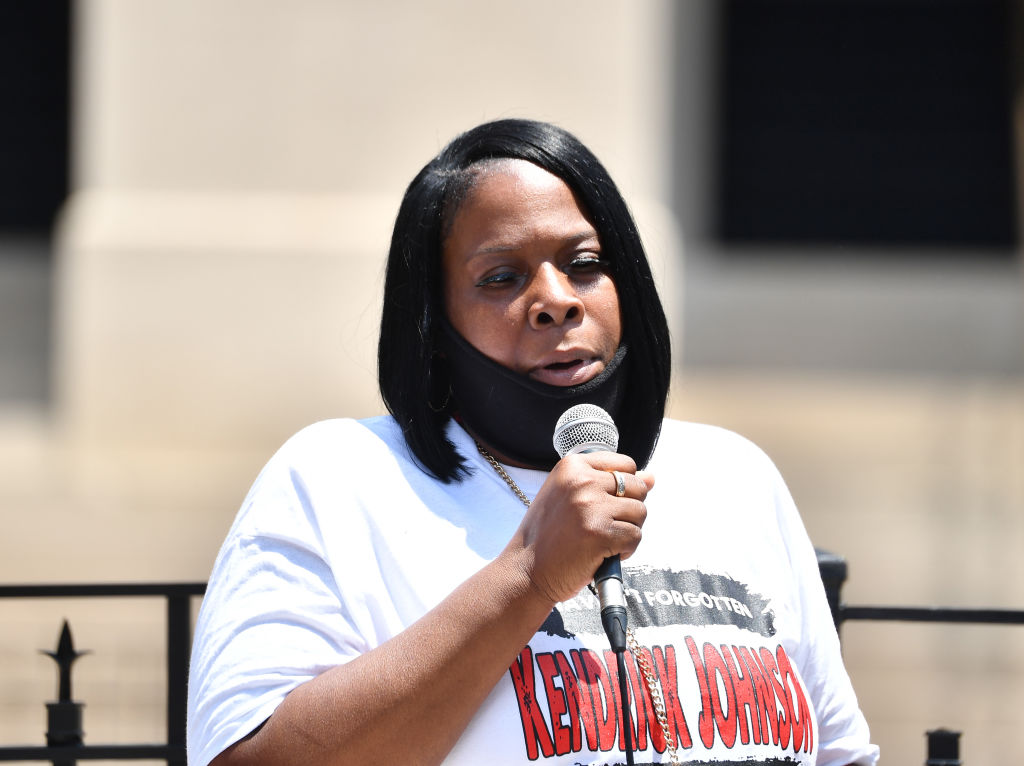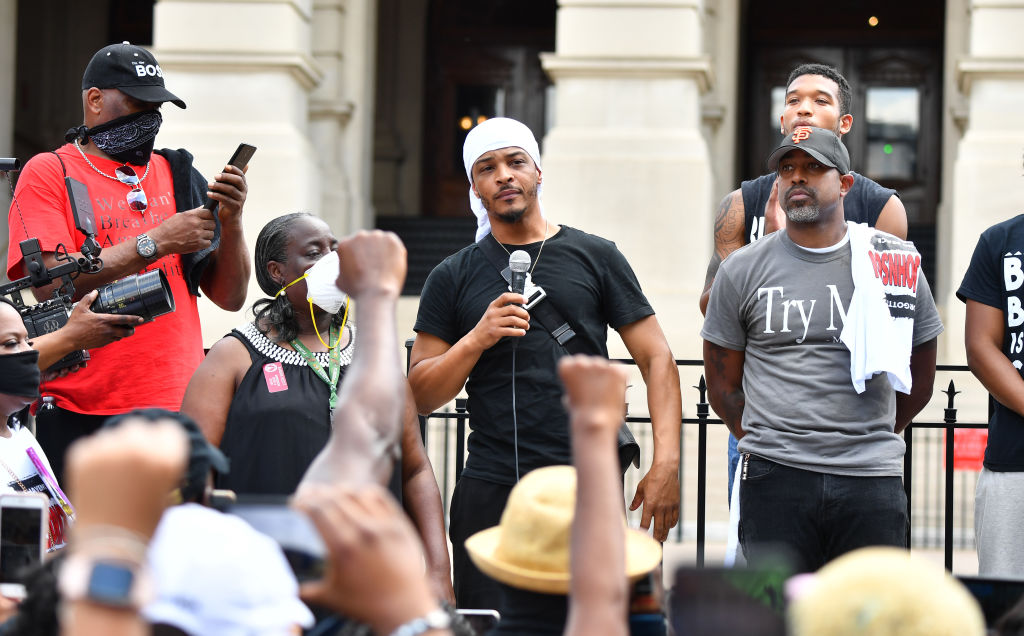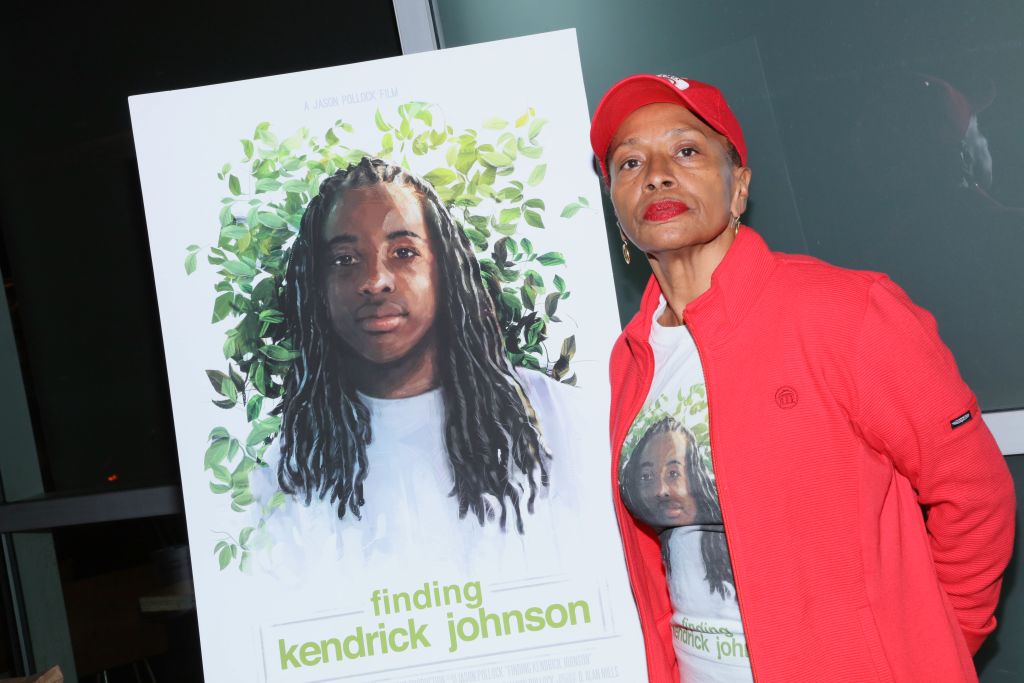
Jackie Johnson, mother of Kendrick Johnson, speaks onstage during the Justice For Kendrick Johnson Rally at the Georgia State Capitol on June 13, 2020, in Atlanta, Georgia. | Source: Paras Griffin / Getty
The mother of Kendrick Johnson, a Black teenager tragically found dead in a wrestling mat at his Georgia high school gym twelve years ago, commemorated this heartbreaking anniversary by amplifying her calls for justice and accountability in a case that remains unresolved. The haunting memory of Kendrick’s death lingers as no one has been held responsible for his death, leaving his family in a continuous fight for answers and closure.
On Friday, Jackie Johnson took to Facebook to remind her followers and the public that her son Kendrick, only 17 at the time, was ?beaten to his death on January 10, 2013, and nothing has been done as of January 10, 2025.? This poignant reminder serves not only to honor her son?s memory but also to reignite the conversation surrounding the need for justice in this harrowing case.
Since that devastating day in 2013, the Johnson family has relentlessly pursued justice for Kendrick. Their efforts have included raising awareness through various initiatives. Notably, in September, Jackie Johnson traveled to Washington, D.C., to represent the Kendrick Johnson Foundation during a press conference. She emphasized the critical details surrounding her son?s mysterious death, mentioning that he was discovered with severe injuries indicative of a violent incident and evidence suggesting the use of a stun gun.
Understanding the Circumstances of Kendrick Johnson’s Death
The initial investigation by the Lowndes County Sheriff?s Office concluded that Kendrick Johnson had attempted to retrieve a shoe that had fallen into the center of a wrestling mat. According to this report, Kendrick became trapped in the mat, which was upright behind the bleachers, and subsequently died from being stuck upside down for an extended period. The authorities stated that Kendrick was alone during this incident, a claim that his family vehemently disputes.
Despite the official narrative, Kendrick’s family has consistently argued that he was murdered, citing troubling signs such as the bloated state of his head and face observed during the initial autopsy. Their insistence on foul play led to a court-approved exhumation of Kendrick?s body for a second autopsy. This independent examination revealed significant findings, including hemorrhaging on the right side of his cheek, leading the pathologist to classify the death as a homicide due to blunt force trauma.
In stark contrast, Lowndes County Coroner Bill Watson defended the original autopsy, attributing Kendrick’s death to ?unexplained,? non-accidental blunt force trauma, asserting that asphyxia was the cause. The lack of suspects in the case persisted, as local authorities continued to support the original findings without further investigation.
Further compounding the mystery, the second autopsy revealed that Kendrick Johnson’s body had been filled with newspapers prior to burial, raising alarming suspicions regarding potential organ harvesting. This shocking revelation prompted Kenneth Johnson, Kendrick?s father, to express his deep disappointment: ?We have been let down again. When we buried Kendrick, we thought we were burying Kendrick, not half of Kendrick.?
The independent pathologist responsible for the second autopsy expressed confusion over the absence of Kendrick’s organs, stating, ?when we got the body, the organs were not there.? This statement added yet another layer of complexity and concern surrounding the mishandling of Kendrick?s remains.

T.I. attends the Justice For Kendrick Johnson Rally at the Georgia State Capitol on June 13, 2020, in Atlanta, Georgia. | Source: Paras Griffin / Getty
In a surprising twist, both the Georgia Bureau of Investigation (GBI)?which conducted the original autopsy?and the Harrington Funeral Home, responsible for embalming and burying Kendrick Johnson, distanced themselves from the controversy surrounding the missing organs. A representative from the GBI claimed that Kendrick?s organs were intact when the body was handed over to the funeral home, while the funeral home asserted that they received the body without any organs.
Furthermore, the Civil Rights Division of the U.S. Department of Justice declared that there was insufficient evidence to warrant a civil rights investigation into Kendrick Johnson?s death?a decision that left many, including his family, disheartened. They felt that the lack of accountability and thorough investigation perpetuated a culture of impunity.
Images taken from the gymnasium at Lowndes County High School starkly illustrated the tragic scene?Kendrick?s shoeless legs were discovered entangled within the wrestling mat. An additional, disturbing photo raised questions about the circumstances of his death, showcasing Kendrick?s bloated face, marred by blood, some of which had pooled on his hair and the floor, indicating a violent end.
In their pursuit of justice, Kendrick Johnson’s family retained the renowned civil rights attorney Ben Crump, who has represented numerous families in similar cases of injustice. Months following the tragic incident, new video footage emerged from the gym, revealing that Kendrick was not alone on the day of his death, contradicting the initial claims made by investigators.
Crump asserted that this video serves as proof of a cover-up, suggesting that there are parties attempting to obscure the truth regarding Kendrick Johnson?s death. The footage depicted Kendrick walking along a corridor before entering the gym, but he mysteriously disappeared from view, raising further suspicions about the events that transpired that day.

Actress Jenifer Lewis attends the Los Angeles rally for Kendrick Johnson and the premiere screening of ?Finding Kendrick Johnson? at Laemmle NoHo 7 on October 29, 2021, in North Hollywood, California. | Source: Robin L Marshall / Getty
Footage that surfaced showed Kendrick traversing the basketball court, followed by another student. However, a subsequent clip abruptly shifted to Kendrick running, with additional students appearing suddenly, raising suspicions of possible video manipulation. This newfound evidence led U.S. Attorney for the Middle District of Georgia, Michael Moore, to announce a federal investigation into Kendrick Johnson’s death, a significant development in the quest for the truth.
Shortly thereafter, Kendrick Johnson’s family initiated legal action against the funeral home responsible for handling his remains, claiming negligence and fraud in the treatment of their son?s body. In the wake of this lawsuit, over 100 individuals, including Kendrick?s former classmates, were subpoenaed by a federal grand jury, highlighting the case’s escalating complexity.
As the second anniversary of Kendrick’s untimely demise approached, his parents filed a substantial $100 million lawsuit against local officials and law enforcement. They accused an FBI agent of suggesting that his sons, who were friends of Kendrick’s, should ?violently assault? him, amplifying the narrative of potential wrongdoing in the case.
The brothers implicated in Kendrick Johnson?s death, Branden and Brian Bell, have consistently denied any involvement or wrongdoing in the tragic incident, maintaining their innocence amid the swirling allegations.

 Share It:
Share It:



